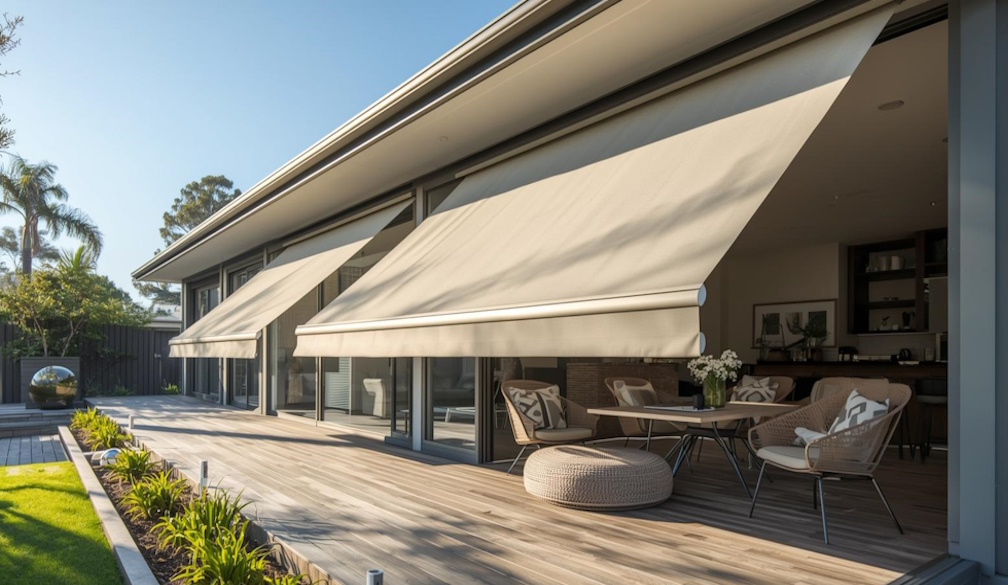Retractable Awnings: The Smart and Stylish Way to Enjoy Outdoor Comfort All Year Round
- Written by Scene Magazine

Creating comfortable, usable outdoor spaces has become a top priority for Melbourne homeowners and business owners alike. Having reliable shade and protection from the elements can transform the way you live and work outdoors. Among the many options available, retractable awnings stand out as one of the most practical, flexible, and visually appealing shade solutions on the market today.
What Are Retractable Awnings
Retractable awnings are flexible shade systems that can be extended or retracted depending on your needs. Unlike fixed awnings, they give you complete control over sunlight and shade. When extended, they provide protection from direct sunlight and light rain, and when retracted, they allow you to enjoy full natural light and an open sky. Available in both manual and motorised versions, retractable awnings can be operated with a crank handle, wall switch, or remote control. Modern models can even be connected to smart systems that automatically adjust based on weather conditions, offering unmatched convenience and comfort.
The Benefits of Retractable Awnings
One of the greatest advantages of retractable awnings is flexibility. Melbourne’s weather can change multiple times in a single day, and having the ability to adjust your awning quickly allows you to stay comfortable regardless of the conditions. During hot summer days, extending the awning keeps your outdoor space cool and shaded, while retracting it during cooler seasons lets in more sunlight to naturally warm your home.
Beyond comfort, retractable awnings are also highly energy-efficient. By blocking direct sunlight from entering windows and doors, they help reduce indoor heat, lowering the need for air conditioning. This simple improvement can lead to significant savings on energy bills while reducing your environmental footprint.
A retractable awning also enhances the look and functionality of your property. With sleek, modern designs and customisable options, it can elevate the aesthetic appeal of your outdoor space while providing year-round practicality.
Residential Applications of Retractable Awnings
For homeowners, retractable awnings are an easy and effective way to extend living areas outdoors. Whether installed over a patio, deck, courtyard, or balcony, they create comfortable spaces for entertaining, dining, or relaxing.
They also protect outdoor furniture from UV damage, keeping your décor looking fresh and new for longer. For families who enjoy outdoor gatherings, a retractable awning provides a versatile shelter that adapts to changing weather — offering shade in summer and openness during cooler months.
Moreover, because retractable awnings are not permanent structures, they are ideal for those looking to enhance their outdoor space without the expense or approval process of a full construction project.
Commercial Benefits for Businesses
In commercial settings, retractable awnings have become increasingly popular among cafés, restaurants, and retail stores. They create shaded alfresco dining areas that attract customers while improving comfort and usability. By protecting patrons from intense sun or sudden showers, they allow businesses to maximise their outdoor seating and revenue potential throughout the year.
For retail shops, retractable awnings not only provide weather protection for customers and window displays but also add to the overall appeal of the storefront. Custom branding can be added to the fabric, making the awning a dual-purpose investment that enhances both functionality and marketing visibility.
Design and Material Options
Modern retractable awnings come in a wide range of designs, fabrics, and frame finishes, ensuring there’s a perfect option for every property style. The fabric plays a crucial role in both performance and appearance. High-quality materials such as acrylic, polyester, and PVC-coated textiles are used for their strength, UV resistance, and weather durability.
Frames are typically made from powder-coated aluminium or stainless steel, ensuring longevity and corrosion resistance even in coastal or high-humidity environments. These materials are lightweight yet robust, providing structural integrity without compromising aesthetics.
Motorised and Smart Control Options
Advancements in technology have made operating retractable awnings easier than ever. Motorised awnings can be controlled with a simple button press or remote, eliminating the effort of manual operation. Some systems also integrate with smart home technology, enabling control through mobile apps or voice commands.
For ultimate convenience and protection, many motorised awnings come with automated sensors that respond to environmental conditions. For example, the awning can automatically extend when the sun intensity increases or retract when strong winds or rain are detected. These features not only ensure comfort but also protect the awning from potential weather damage.
Durability and Maintenance
Retractable awnings are built to last, especially when properly maintained. Their durable fabrics and rust-resistant frames can withstand Melbourne’s diverse weather patterns, from summer heat to occasional rain and wind.
Regular maintenance is simple — occasional cleaning with mild soap and water keeps the fabric looking fresh, while periodic checks on the frame and mechanisms ensure smooth operation. Retracting the awning during storms or extreme weather helps preserve its longevity.
Professional installation is key to ensuring proper alignment and functionality. Many Melbourne awning specialists offer warranties and after-sales services, giving customers confidence and peace of mind.
Energy Efficiency and Environmental Impact
In addition to comfort and aesthetics, retractable awnings contribute to sustainability. By reducing the amount of heat entering your home or business, they minimise the need for artificial cooling. This lowers electricity usage and supports energy conservation.
In cooler months, retracting the awning allows natural sunlight to enter, providing passive heating. This year-round adaptability makes retractable awnings one of the simplest and most effective ways to improve energy efficiency and comfort simultaneously.
Conclusion
A retractable awning is one of the most versatile and stylish additions you can make to your home or business. It provides instant shade and comfort when needed and effortlessly retracts to let in sunlight when desired. Combining elegance, practicality, and energy efficiency, retractable awnings are ideal for Melbourne’s diverse climate and modern living standards.


















